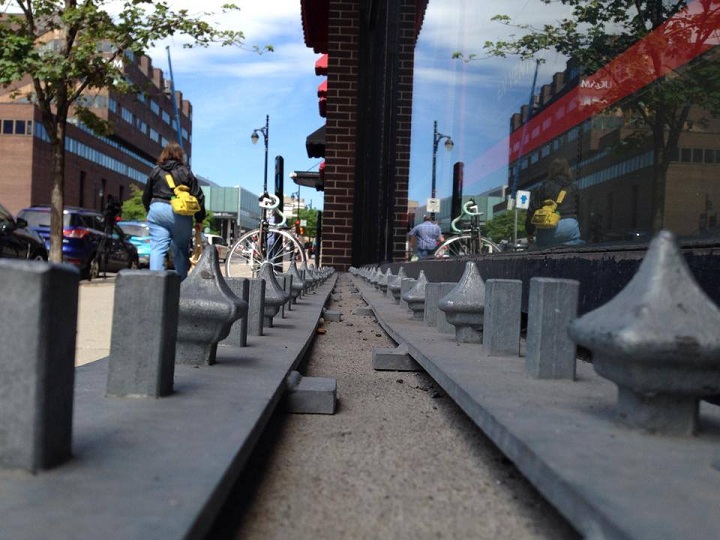London’s mayor Boris Johnson slammed the owner of an upscale apartment building for installing metal spikes in concrete to keep homeless people from sleeping on the ground outside.

Advocates for the homeless in the U.K and beyond have expressed disgust over such spikes, which have also appeared outside businesses such as British grocery store chain Tesco’s, which said the spikes are hinder “anti-social behaviour.”
Similar spikes were spotted outside Montreal music and book store Archambault, at the corner of Ste. Catherine St. E and Berri St. on Tuesday and were promptly removed after Mayor Denis Coderre said they were “a disgrace” to the city.
“We’re sending the wrong message,” Coderre told reporters. “This is not the kind of city I want to live in.”
He also said it was a danger to the public safety as a whole.
READ MORE: ‘Homeless spikes’ removed after controversy in Montreal
Although Archambault is owned by Quebecor, the media company said it had nothing to do with the spikes and that it did not own the building. Workers began removing the spikes around 11:30 a.m. local time.
Efforts to deter homeless people using tactics such as spikes don’t deal with the real issue, said Tim Richter, president of the Calgary-based Canadian Alliance to End Homelessness. They just move it out of sight.
“This is among the indignities that homeless people will experience on a day-to-day basis,” he said. “If you want to address the issue of homeless people in public spaces then we need to deal with homelessness.”
He said other forms of physical deterrents exist in other Canadian cities, but they aren’t as obvious as the spikes in London and Montreal. Some surfaces in Calgary, for example, “have these pyramid-shaped marble attachments,” he said. “So, it just looks like it was a part of the design feature. But, it’s clearly designed to keep people from lying down.”
Richter said that example was outside C-train stations.
In response to a query from Global News, city spokesperson Sean Somers said, as far as public property is concerned, the city has made efforts to deter pigeons from landing on high ledges or to prevent skateboarders from sliding on rails or surfaces, but not to discourage homeless people from sitting or lying down.
Somers said he was aware of the “pyramid-like” attachments spotted outside of a C-train station and he was looking into whether they were a part of city-owned property or the adjacent building.
Other measures to deter homeless people from gathering or sleeping in urban areas have also ended in public relations nightmares.
Take for example Abbotsford, B.C.
Last year, city workers dumped a truck load chicken excrement in an area across from a Salvation Army where homeless people were known to gather and set up camp.
Mayor Bruce Banman had to issue a public apology following the chicken feces fallout and two city workers ended up leaving their jobs.
READ MORE: Abbotsford apologizes for using manure to drive out homeless
The incident and the criticism became the focus of a documentary film, called The Chicken Manure Incident, and a human rights complaint.
Port Coquitlam, Surrey and Port Moody used the same tactic and were met with public condemnation.
At least 33 U.S. cities have forbidden or considered prohibiting groups and individuals from sharing food with homeless people in public spaces without a permit.
A report from NBC News on May 12 detailed the story of a Florida couple fined for feeding homeless people home-cooked meals in a Daytona Beach park.
“We as a city have spent millions of dollars to turn that park into a place for families, kids and dog lovers,” Daytona Beach Police Chief Mike Chitwood told NBC at the time. “We have an ordinance that says when people want to perform acts of kindness or charity that they must coordinate with our local social service agencies.”
“People want to find a way to deal with the immediate problem,” Richter said.
“These are reactions. They’re not really good reactions,” he said. “But it’s a great opportunity to shift the conversation.”
Richter said the Abbotsford incident was actually a good example of how a positive came out of a negative situation and the public engaged in debate over how to help homeless people, rather than push it out of sight.
“The vast majority of people want to do the right thing.”























Comments